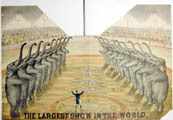|
The introduction of wild animals to the circus dates from about 1819 when the French trainer Henri Martin (1793-1882) performing in Nuremburg, Germany entered a cage with a tiger. However, an American, Isaac A. Van Amburgh (1801-1865) was the first “modern” wild animal trainer who captured the public’s imagination and gained notoriety as a zoologist. The New York Mirror in July 7, 1838 said this about Van Amburgh.
“His fearless acts of placing his bare arm moist with blood, in the lion’s mouth and thrusting his head into the distended jaws of the tiger—the playful tenderness of the lion and the tiger toward the infant and the pet lamb, who are put into the same cage with them—are all attended with the most thrilling and dramatic interest.”
Later in July, Van Amburgh took his act to England and Europe for seven years. While in England, he performed before Queen Victoria. The Queen was so fascinated with him that she commissioned the artist Edwin Landseer to paint a portrait of him in the cage with his cats.
When Van Amburgh returned from Europe, his fame preceded him. A menagerie was named Van Amburgh and Company and his name continued was used in circus and menagerie titles until 1921.
Stuart Thayer in his Band Wagon article, “The keeper Will Enter The Cage: Early American Wild Animal Trainers,” November-December 1982 suggests that many writers credit Van Amburgh with being the first American trainer, however there may have been as many as nine men in the profession prior to his appearance. Thayer points out that these predecessors had a different style than that of Van Amburgh. These men, as Thayer mentions, were humane, as opposed to Van Amburgh’s style in the cage. Several sources note that Van Amburgh used a crowbar to apparently beat his cats into submission.
Although wild animal acts were popular, there were protestations against the use of wild animals in the circus—specifically cats elephants and bears. The objections, coming as early as the first decade of the twentieth century, were raised because of the suspected use of inhumane methods of training.
Wild animal acts dwindle in popularity in the American circus between 1870’s and 1920s. Barnum and Bailey had one wild animal act between 1871 and 1918. John Ringling felt that the wild animal acts were dangerous, and were a nuisance to transport and set up. However, by 1910, a number of smaller circuses were using wild animals and by the 1920s, they were appearing on the major circuses. In 1921 John Ringling acquiesced and the Ringling Bros. Circus presented three arenas of wild animals. In 1922, the Ringling’s featured seven animal acts; 1923 eight; and in 1924 they featured four wild animal acts. In 1925 the Ringling circus dropped the wild animal acts, however other circuses continued to use wild animals in their shows. Joanne Carol joys in her book The Wild Animal Trainer in America states that “The high point was reached during the “Jazz Age” when over fifty animal trainers plied their trade….They became the mainstay and feature in all American shows, including Ringling Bros. and Barnum & Bailey.” (p. 61)
Mable Stark worked in what was a prominently male dominated profession. Mable gained stardom with the A.G. Barnes Circus and with the Ringling Brothers and Barnum and Bailey Circus. She became a featured act in the A.G. Barnes Circus, where she wrestled Rajah, a 350-pound Bengal tiger. A petite blond never weighing more than 114 pounds wrestling a 350-pound tiger was a consistent crowd-pleaser. In 1922 Mabel joined the Ringling Bros. and Barnum & Bailey Circus and quickly became a “center ring” performer.
Clyde Beatty style of presenting his wild animals was different that Alfred Court and Mabel Stark—his was loud, noisy and showy. Using a whip, chair and gun, Clyde Beatty moved his cats around the steel cage with using the chair and the gun to fend off his cats. This was, however part of his showy act. Beatty started as a cage boy with Howe’s Great London Shows and worked with Louis Roth who was the same trainer that tutored Mabel Stark. In 1925 joined the Hagenbeck-Wallace Circus were he presented a mixed cat act consisting of lions, pumas bears and leopards. After the 1925 season Beatty fame thrust him into the center ring where he stayed for the remainder of his career. In comparing Beatty to Court, Court wanted the audience to focus their attention of the animals, not on him. Beatty was the opposite with the attention always on him using the time-honored American tradition of the “fighting act.”
| 






